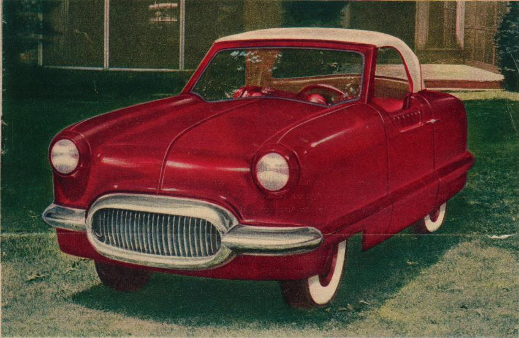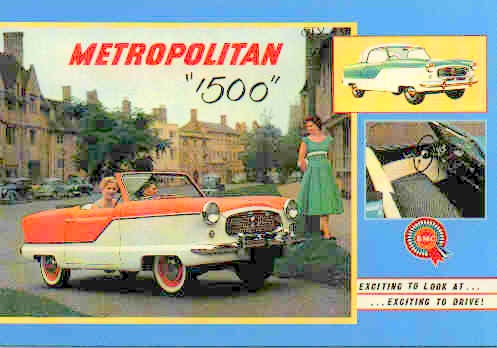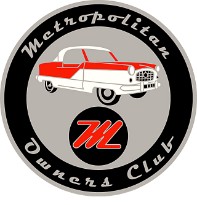A Brief History of the Metropolitan
In the late 1940s US car manufacturers consisted of the "Big Three" (General Motors, Ford and Chrysler) as well as a number of smaller companies including Nash, Hudson, Packard & Studebaker. Nash Motors was the automotive arm of Nash-Kelvinator and was led by the innovative George Mason. Whilst the other companies continued on from where they had left off before war-time, Nash Motors felt that the market had changed. They realised that women, who had become involved in wartime production, now played an ever increasing role in US society. Women were now more likely to be working, and also families were now moving out to the suburbs, and there was a real need for affordable transportation as many families would need two cars.
If Nash Motors were to survive, they would not be able to tackle the "Big Three" head-on with similar cars that they produced. Instead they would be better off to try to fill "niche" markets that the other manufacturers were not addressing. Mason's attention was drawn to a freelance automotive designer named William Flajole, who had identified that a small car built to American standards had a potential market. Nash Motors commissioned Flajole to build a prototype vehicle using this concept, based on the original Fiat 500 (the Topolino) and incorporating several innovative features - quite revolutionary in those days of big gas guzzlers. This prototype was called the "NXI" (Nash Experimental International). It was planned that the front and rear wings, as well as the doors, would be interchangeable in order to cut costs, but by the time the production car arrived the wings were unique front and rear, but the doors were interchangeable.

The NXI (Nash Experimental International)
Mason was still not sure whether to put the project into production, so he set about displaying the prototype at "Surviews" (Survey/Previews) around the country, and inviting automotive executives, motoring journalists etc. to view the NXI and give their opinions via a Questionnaire, which was an innovative marketing strategy for the time. The car was shown with two engines, a small Fiat (Italian) engine and a larger Standard (UK) engine, and the reaction convinced Nash that there was in fact a market for a new small car - America's sub-compact car! While it resembled the "bathtub" design of the massive Ambassador, it had a significantly smaller wheelbase.
Already Nash had realised that such a vehicle would be difficult to make in the US where the factories were geared to larger cars and engines, so it was decided to produce the car in Europe. Conversations were had with Fiat and Standard-Triumph, hence the prototype being shown with the two engines, but the Austin Motor Company was ultimately awarded the contract in view of their reputation for quality build and engineering. They were to build a car that would use a combination of A30 and A40 running gear.
Following various design modifications, the first Metropolitans rolled off the Longbridge production line in October 1953, and went on sale in the US in the spring of 1954, priced at $1445 for the coupé and $1469 for the convertible. Originally badged as the NX1, Nash decided that actually it's name should reflect the urban habitat it was designed for and as such it would be called the Metropolitan.
Early versions were fitted with the 1200cc Austin A40 engines, delivering 39bhp which was enough to push the 816kg vehicle to a top speed of 70mph. The Metropolitan charged from 0 to 60 mph in 22.4 seconds, notably quicker than the Beetle which was the direct competitor of the Metropolitan in the US market. The production car was also stretched by 7 inches from the prototype 6ft 6in wheelbase. None of these early cars were released on the UK market, the entire production until 1957 was for export only. By the time the first Metropolitans arrived in America, Nash had merged with another of the smaller copmanies, Hudson, to become American Motors Corporation (AMC). Metropolitans were badged as either Nashes or Hudsons, depending upon which dealer sold them.

Postcard showing early production Hudson Metropolitan
A facelift in 1956 saw a 1489cc Austin A50 engine for extra liveliness (delivering 55bhp and top speeds of 80mph), and it was this facelift that eventually went on sale in the UK in 1957 as an Austin, having already earned millions of vital dollars for the British car industry and was reputed to be second only to the Volkswagen Beetle in terms of volume car imports to the States at that time. The engine had been upgraded to the proven BMC "B" series 1500cc unit used in a wide variety of other BMC cars, which had a power output of around 55bhp, giving quite a lively performance in such a light-bodied car. The car was not known as a Nash in the UK though it is sometimes wrongly referred to as such. UK-supplied cars are correctly described as Austin Metropolitans, though they join the ranks of a minute number of cars produced in the world which do not bear a manufacturer's badge - simply known as the Metropolitan.
From 1957 on, all cars were duo-toned with white, with the main body colour (red, green, yellow and later black) separated by a stepped stainless steel moulding. The Metropolitan was to stay in production until 1961 with only minor changes in 1959 to accommodate an opening boot lid, one-piece rear window and quarter lights in the doors.

British advertising postcard
In total, the Metropolitan was on sale for 7 years and 104,000 were sold - 9,000 of which were outside of the US. Whilst this may not have been enough to worry the "Big Three", it did just fine for Nash and Austin, with the British company making $35 million in the first five years, from tooling costs of just $800,000.
Today the Metropolitan is a rare sight on British roads, although there are higher numbers remaining in North America, the true source of the inspiration for this remarkable little car. One of the very few cars that swam against the "bigger is better" trend of the 1950s, the Metropolitan enjoys a cult following. Some think it's a cute car, while others find it downright ugly to look at. But most agree that the Metropolitan was ahead of its time and performed well against subcompact imports. Some 60 years later and these once-affordable "bathtubs on wheels" can fetch more than £30,000 in Concours-ready condition.
